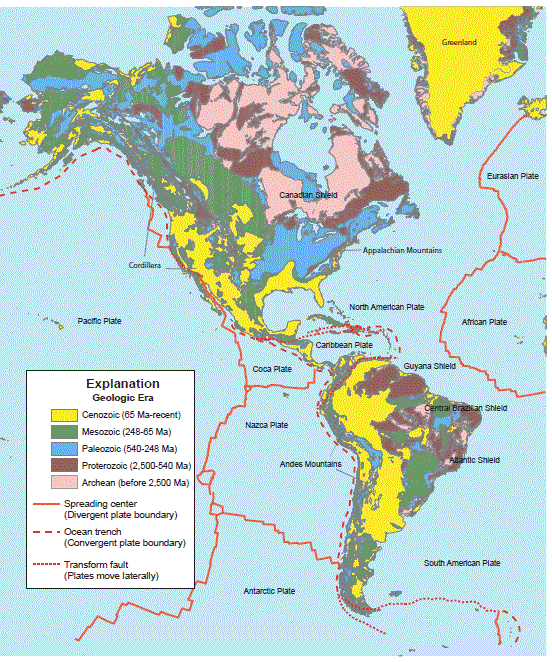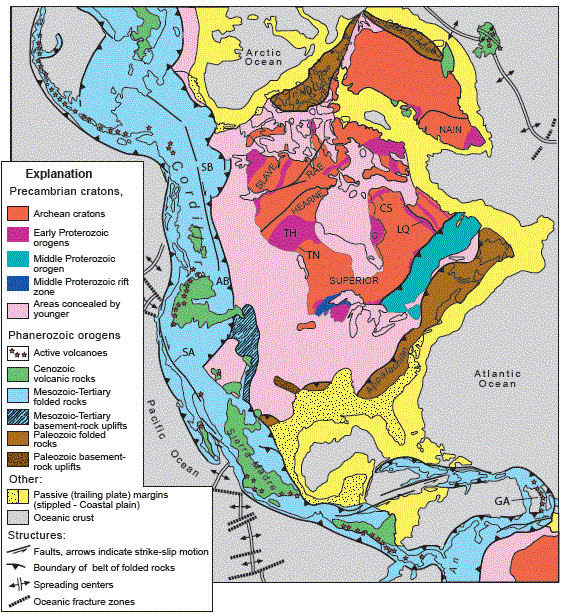OF 2005-1294-B. Geology
and Nonfuel Mineral Deposits of Latin America and Canada(110p)
Contents
Contents........................................................................................................................................................................iii
Abstract........................................................................................................................................................................1
Introduction...............................................................................................................................................................2
Regional geologic framework....................................................................................................................3
Major geologic provinces and structures..................................................................................................................3
Overview of geologic and tectonic history................................................................................................................4
Principal commodities and mineral deposits...............................................................................7
Metals.............................................................................................................................................................................7
Aluminum.....................................................................................................................................................................8
Antimony......................................................................................................................................................................8
Columbium (Niobium)................................................................................................................................................9
Copper........................................................................................................................................................................10
Gold.............................................................................................................................................................................11
Iron ore......................................................................................................................................................................13
Lead and Zinc...........................................................................................................................................................14
Manganese...............................................................................................................................................................17
Molybdenum.............................................................................................................................................................18
Nickel and Cobalt.....................................................................................................................................................19
Platinum-group elements.......................................................................................................................................21
Silver...........................................................................................................................................................................22
Tin...............................................................................................................................................................................23
Titanium.....................................................................................................................................................................23
Tungsten....................................................................................................................................................................25
Industrial minerals.....................................................................................................................................................26
Asbestos....................................................................................................................................................................26
Barite..........................................................................................................................................................................26
Boron..........................................................................................................................................................................27
Clay (Kaolin)..............................................................................................................................................................28
Gemstones................................................................................................................................................................28
Fluorspar....................................................................................................................................................................30
Graphite.....................................................................................................................................................................30
Gypsum......................................................................................................................................................................31
Lithium........................................................................................................................................................................31
Limestone and other carbonate rocks..................................................................................................................32
Magnesium...............................................................................................................................................................32
Phosphate.................................................................................................................................................................33
Potash (Potassium)..................................................................................................................................................34
Halite (salt)................................................................................................................................................................34
Strontium...................................................................................................................................................................35
Sulfur..........................................................................................................................................................................36
Regional exploration history and significant recent discoveries............................36
Potential for undiscovered mineral resources.........................................................................39
Acknowledgements..........................................................................................................................................43
References Cited................................................................................................................................................43
Tables...........................................................................................................................................................................60
Figures..........................................................................................................................................................................78
Tables
Table 1. Principal nonfuel mineral commodities produced in Latin
America and Canada...............................60
Table 2. Mineral deposit name, location, principal commodities,
type, and references for the principal mineral deposits in Latin
America and Canada...62
Table 3. Mineral deposit types and examples...........................................................................................................77
Table 4. Bauxite - proportion of world mine production, reserves,
and reserve base for countries covered by this report..8
Table 5. Antimony - proportion of world mine production, reserves,
and reserve base for countries covered by this report...9
Table 6. Columbium - proportion of world mine production, reserves,
and reserve base for countries covered by this report...9
Table 7. Copper - proportion of world mine production, reserves,
reserve base, and resource base for countries covered by this
report...10
Table 8. Gold - proportion of world mine production, reserves,
and reserve base for countries covered by this report...11
Table 9. Iron ore - proportion of world mine production, reserves,
and reserve base for countries covered by this report...13
Table 10. Lead - proportion of world mine production, reserves,
and reserve base for countries covered by this report...14
Table 11. Zinc - proportion of world mine production, reserves,
and reserve base for countries covered by this report...15
Table 12a. Manganese - proportion of world mine production, reserves,
and reserve base for countries covered by this report...17
Table 12b. Manganese resources in the ocean.......................................................................................................18
Table 13. Molybdenum - proportion of world mine production, reserves,
and reserve base for countries covered by this report...19
Table 14. Nickel - proportion of world mine production, reserves,
and reserve base for countries covered by this report...19
Table 15. Cobalt - proportion of world mine production, reserves,
and reserve base for countries covered by this report...20
Table 16. Platinum-group elements - proportion of world mine production,
reserves, and reserve base for countries covered by this report...21
Table 17. Silver - proportion of world mine production, reserves,
and reserve base for countries covered by this report...22
Table 18. Tin - proportion of world mine production, reserves,
and reserve base for countries covered by this report...23
Table 19. Titanium concentrate (ilmenite) - proportion of world
mine production, reserves, and reserve base for countries covered
by this report
...24
Table 20. Tungsten - proportion of world mine production, reserves,
and reserve base for countries covered by this report...25
Table 21. Asbestos - proportion of world mine production, reserves,
and reserve base for countries covered by this report...26
Table 22. Barite - proportion of world mine production, reserves,
and reserve base for countries covered by this report...27
Table 23. Boron - proportion of world mine production, reserves,
and reserve base for countries covered by this report...27
Table 24. Fluorspar - proportion of world mine production, reserves,
and reserve base for countries covered by this report...30
Table 25. Graphite - proportion of world mine production, reserves,
and reserve base for countries covered by this report...30
Table 26. Gypsum - proportion of world mine production for countries
covered by this report...31
Table 27. Lithium - proportion of world mine production, reserves,
and reserve base for countries covered by this report...32
Table 28. Magnesium compounds - proportion of world mine production,
reserves, and reserve base for countries covered by this report...33
Table 29. Phosphate rock - proportion of world mine production,
reserves, and reserve base for countries covered by this report...33
Table 30. Potassium - proportion of world mine production, reserves,
and reserve base for countries covered by this report...34
Table 31. Salt - proportion of world mine production for countries
covered by this report ...35
Table 32. Strontium - proportion of world mine production for
countries covered by this report...35
Figures
Figure 1. Areas of the regional reports...78
Figure 2. Location of countries covered in this report and the
names of states and provinces in Latin America and Canada...79
Figure 3. Digital elevation image of North and South America ...80
Figure 4. Principal layers of the Earth...81
Figure 5. Diagram illustrating the plate tectonic setting in which
mineral deposits are formed...82
Figure 6. Geologic map of Latin America and Canada showing the
age and distribution of principal rock units, and the location
of tectonic plates and plate boundaries...83
Figure 7. Map showing selected geologic and tectonic features
of North America...84
Figure 8. Map showing selected geologic and tectonic features
of South America discussed in the text...85
Figure 9a. Distribution of principal nonfuel mineral deposits
in Latin America and Canada by deposit type...86
Figure 9b. Location and deposit type of major deposits of copper,
lead, and zinc...87
Figure 9c. Location and deposit type of major deposits of antimony,
fluorspar (fluorite), gold, and silver...88
Figure 9d. Location and deposit type of major deposits of boron,
diatomite, gypsum, halite, iodine, iron, kaolin, limestone, lithium,
manganese, phosphate, potash, sodium carbonate, strontium, and
uranium...89
Figure 9e. Location and deposit type of major deposits of aluminum,
columbium, gemstones, mica, molybdenum, nickel, palladium, platinum,
sulfur, syenite, tantalum, tin, and titanium...90
Figure 9f. Location and deposit type of major deposits of asbestos,
barite, graphite, magnesium, pyrophyllite, talc, tungsten, and
wollastonite...91
Figure 10a. Schematic laterite profile showing the progression
of weathering effects on rock...92
Figure 10b. Cross section of a stratovolcano showing the relative
locations of porphyry copper deposits, lead-zinc veins, gold-silver
veins, and sulfur deposits...93
Figure 10c. Formation of placer gold deposits...94
Figure 10d. Extensional tectonic setting where plates are moving
away from each other...95
Figure 10e. Cross section schematically illustrating the characteristic
features of volcanogenic massive sulfide (VMS) deposits...96
Figure 10f. Cross section schematically illustrating the characteristic
features of sedex lead and zinc deposits...97
Figure 10g. Longitudinal section through the West Field, Santa
Eulalia mining district of Mexico showing the distribution and
shape of silver-zinc-lead ore bodies relative to sedimentary rock
units...98
Figure 10h. Pink rhodochrosite (manganese, carbon, and oxygen)
from Argentina ...99
Figure 10i. Simplified geologic map of the Sudbury Igneous Complex,
showing locations of some of the more important nickel-copper
mines...100
Figure 10j. Chalcopyrite-rich veins (yellow) cutting gneiss in
the Sudbury Igneous Complex, Strathcona mine, Ontario...101
Figure 10k. Cerro Rico de Potosi, Bolivia, the world’s biggest
silver deposit ...102
Figure 10l. Purple amethyst quartz crystal from Brazil...103
Figure 10m. Model of a diamond kimberlite pipe....104
Abstract
A nation’s endowment of nonfuel mineral resources, relative
to the world’s endowment, is a fundamental consideration in decisions
related to a nation’s economic and environmental well being and
security. Knowledge of the worldwide abundance, distribution,
and general geologic setting of mineral commodities provides a
framework within which a nation can make decisions about economic
development of its own resources, and the economic and environmental
consequences of those decisions, in a global perspective. The
information in this report is part of a U.S. Geological Survey
(USGS) endeavor to evaluate the global endowment of both identified
and undiscovered nonfuel mineral resources. The results will delineate
areas of the world that are geologically permissive for the occurrence
of undiscovered selected nonfuel mineral resources together with
estimates of the quantity and quality of the resources. The results
will be published as a series of regional reports; this one provides
basic data on the identified resources and geologic setting, together
with a brief appraisal of the potential for undiscovered mineral
resources in Latin America and Canada. Additional information,
such as production statistics, economic factors that affect the
mineral industries of the region, and historical information,
is available in USGS publications such as the Minerals Yearbook
and the annual Mineral Commodity Summaries (available at http://minerals.usgs.gov/minerals).
The region covered in this report is a major producer of mineral
commodities like copper (53 percent of world production in 2004),
silver (48 percent), zinc (30 percent), nickel (32 percent), molybdenum
(43 percent), iron ore (29 percent),gold (21 percent), lead (18
percent), primary aluminum (17 percent), salt (19 percent), and
manganese (12 percent). In addition, the countries inthe region
are among the world’s major producers, or have significant reserves
of antimony, asbestos, barium, beryllium, bismuth, boron, cobalt,
fluorite, graphite, gypsum, indium, iodine, kaolin, magnesite,
niobium, nitrate, potash, selenium, strontium, tellurium, tin,
titanium, and tungsten. The United States does not produce enough
of some mineral commodities to supply all of its current domestic
demand, and it relies on imports to satisfy these needs. In 2004,
the United States imported 100 percent of its arsenic, asbestos,
bauxite and alumina, columbium (niobium), fluorspar, graphite,
indium, manganese, mica, industrial quartz crystal, rare earths,
rubidium, strontium, thallium, thorium, vanadium, and yttrium
from sources that include countries in this region. Although Latin
America and Canada are rich in mineral resources (both identified
and undiscovered), increasing concerns about the environmental
and societal impacts of minerals development in the region are
increasingly affecting the progress of new exploration and development
activities.
A recurrent theme of this report is thatmineral deposits are associated
with large-scale geologic processes that reoccur in time and place.
Mineral deposits do not occur randomly; their distribution is
intimately related to the geologic history of each continent.
The more we know about the geologic fabric of each continent and
the processes that control the regional and local distribution
of mineral deposits, the better we can answer where new deposits
will be found and what they will contain.

Figure 6. Geologic map of Latin America and Canada
showing the age and distribution of principal rock units, and
the location of tectonic plates and plate boundaries

Figure 7.
Map showing selected geologic and tectonic features of
North America. Names of Middle Proterozoic and younger orogens
are shown on the map (Grenville, Appalachian, Caledonides, Innuitian,
Cordillera, Sierra Madre, Andean). Archean shield names are given
in all-capital type. Other localities abbreviated as follows:
AB - Aldridge-Belt basin; CS - Cape Smith fold belt; GA - Greater
Antilles chain of volcanic islands; LQ - Labrador -Quebec fold
belt; SA - San Andreas fault; SB - Selwyn basin; TH - Trans-Hudson
orogen; and TN - Thompson nickel belt. Modified from Bally and
others (1989) and Hoffman (1989).

Figure 8.
Map showing selected geologic and tectonic features of
South America discussed in the text. Modified from Milani and
Filho, 2000.

Figure 9a. Distribution of principal nonfuel mineral deposits
in Latin America and Canada by deposit type. There is a tendency
for surficial deposits to form in tropical settings near the
equator, for hydrothermal deposits to be in mountain ranges,
and for igneous deposits to be localized in stable shields.

Figure 10e.
Cross section schematically illustrating the characteristic features
of volcanogenic
massive sulfide (VMS) deposits. Hydrothermal fluids move
upwards along fractures in volcanic rocks towards open water
. When the hot hydrothermal fluids vent and mix with cold ocean
water, iron, copper , lead, and zinc sulfide minerals form and
collect as a mound on the sea floor. Ore minerals also can form
in the fractures underlying the mound of sulfide minerals. Modified
from Lydon (1988).
USGSによる『Geology
and Nonfuel Mineral Deposits of Latin America and Canada』から |
戻る




